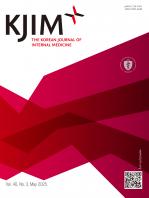|
Nephrology / Review
Recent updates in therapeutic approach using tolvaptan for autosomal dominant polycystic kidney disease
Yaerim Kim, Seungyeup Han
Korean J Intern Med. 2023;38(3):322-331. Published online April 25, 2023
As a genetic disease, there has been a long-standing effort to identify therapeutic options for autosomal dominant polycystic kidney disease (ADPKD). Following the development of tolvaptan, a vasopressin 2 receptor antagonist, the treatment strategy for ADPKD patients with rapid disease progression ..
|
|
|
Review
Clinical and genetic characteristics of Korean autosomal dominant polycystic kidney disease patients
Yun Kyu Oh, Hayne Cho Park, Hyunjin Ryu, Yong-Chul Kim, Kook-Hwan Oh
Korean J Intern Med. 2021;36(4):767-779. Published online July 1, 2021
Autosomal dominant polycystic kidney disease (ADPKD) is the most common hereditary kidney disease. It is characterized by cyst growth in the kidneys, resulting in kidney enlargement and end-stage kidney disease. The polycystic kidney disease 1 (PKD1) and PKD2 have been identified as ge..
|
|
|
Hemato-oncology / Original Article
Role of concurrent chemoradiation on locally advanced unresectable adenoid cystic carcinoma
Hyerim Ha, Bhumsuk Keam, Chan-Young Ock, Tae Min Kim, Jin Ho Kim, Eun-Jae Chung, Seong Keun Kwon, Soon-Hyun Ahn, Hong-Gyun Wu, Myung-Whun Sung, Dae Seog Heo
Korean J Intern Med. 2021;36(1):175-181. Published online March 30, 2020
Background/Aims: Adenoid cystic carcinoma (ACC) is a rare salivary gland tumor characterized by indolence, with a high rate of local recurrence and distant metastasis. This study aimed to investigate the effect of concurrent chemoradiation (CCRT) on locally advanced unresectable ACC.
Methods: We re..
|
|
|
Pulmonology / Original Article
Evaluation of high resolution computed tomography findings of cystic fibrosis
Ayse Senay Sasihuseyinoglu, Derya Ufuk Altıntaş, Sureyya Soyupak, Dilek Dogruel, Mustafa Yılmaz, Mahir Serbes, Gulsah Duyuler
Korean J Intern Med. 2019;34(2):335-343. Published online July 6, 2018
Background/Aims: Morphological changes due to lung disease in patients with cystic fibrosis (CF) were evaluated using high resolution computed tomography (HRCT), and the HRCT scores obtained using the Bhalla scoring system were correlated with those obtained using clinical and laboratory indicators...
|
|
|
Letter to the editor
Xp11.2 translocation renal cell carcinoma in the autosomal dominant polycystic kidney disease patient with preserved renal function
Hyuk Huh, Hyung Ah Jo, YongJin Yi, Seung Hyup Kim, Kyung Chul Moon, Curie Ahn, Hayne Cho Park
Korean J Intern Med. 2017;32(6):1108-1111. Published online October 17, 2017
|
|
|
Endocrinology-metabolism / Original Article
Differentiation between polycystic ovary syndrome and polycystic ovarian morphology by means of an anti-Müllerian hormone cutoff value
Do Kyeong Song, Jee-Young Oh, Hyejin Lee, Yeon-Ah Sung
Korean J Intern Med. 2017;32(4):690-698. Published online November 30, 2016
Background/Aims: Although increased serum anti-Müllerian hormone (AMH) level has been suggested to be a surrogate marker of polycystic ovarian morphology (PCOM), its association with polycystic ovary syndrome (PCOS) is controversial, and its diagnostic value has not been determined. We aimed to ob..
|
|
|
Pulmonology / Review
Diagnosis and treatment of cystic lung disease
Sanghoon Park, Eun Joo Lee
Korean J Intern Med. 2017;32(2):229-238. Published online February 28, 2017
Cystic lung disease (CLD) is a group of lung disorders characterized by the presence of multiple cysts, defined as air-filled lucencies or low-attenuating areas, bordered by a thin wall (usually < 2 mm). The recognition of CLDs has increased with the widespread use of computed tomography. This artic..
|
|
|
Endocrinology-metabolism / Original Article
Adipokines, insulin-like growth factor binding protein-3 levels, and insulin sensitivity in women with polycystic ovary syndrome
Hyejin Lee, Jee-Young Oh, Yeon-Ah Sung
Korean J Intern Med. 2013;28(4):456-463. Published online July 1, 2013
Background/AimsMany women with polycystic ovary syndrome (PCOS) exhibit insulin resistance. Adipose tissue plays an important role in insulin resistance, and adipokines including tumor necrosis factor (TNF)-α and adiponectin are altered in PCOS. Insulin-like growth factor bin..
|
|
|
Original Article
Serum C-Reactive Protein Levels in Normal-Weight Polycystic Ovary Syndrome
Ji Young Oh, Ji-Ah Lee, Hyejin Lee, Jee-Young Oh, Yeon-Ah Sung, Hyewon Chung
Korean J Intern Med. 2009;24(4):350-355. Published online November 27, 2009
Background/AimsSerum levels of highly sensitive C-reactive protein (hsCRP), a vascular inflammatory marker, may predict the development of cardiovascular disease (CVD) and type 2 diabetes. Women with polycystic ovary syndrome (PCOS) are at greater risk for type 2 diabetes and ..
|
|
|
Review
Autosomal Dominant Polycystic Kidney Disease: 2009 Update for Internists
William M. Bennett
Korean J Intern Med. 2009;24(3):165-168. Published online August 26, 2009
Because autosomal dominant polycystic kidney disease (ADPKD) is one of the most common genetic abnormalities seen in today's medical practice, many internists will likely treat patients affected by this condition. Genetic abnormalities have been increasingly recognized, and the pathophysiology of..
|
|
|
Case Report
Unusual Presentation of Cystic Lymphangioma of the Gallbladder
Yong Sik Woo, Kwang Ro Joo, Kyung-Yup Kim, Won Taek Oh, Youn Hwa Kim
Korean J Intern Med. 2007;22(3):197-200. Published online September 30, 2007
Cystic lymphangioma of the gallbladder is quite a rare tumor with only a few cases having been reported in the literature. We describe here a rare case of cystic lymphangioma of the gallbladder, which was unusual in that the patient presented with biliary pain and an abnormal liver test. Ultrason..
|
|
|
Review
The Urine Urokinase Concentration in End Stage Renal Disease with Acquired Renal Cyst
Sae Yong Hong, Dong Ho Yang, Byoung Ho Lee, Eun Kyong Ki, Kang Hoe Chung
Korean J Intern Med. 1991;6(2):64-69. Published online July 1, 1991
To see whether there was any difference in the urine urokinase concentration between acquired cystic kidney disease (ACKD) group and control (non cyst) group in end stage renal disease patients (ESRD), we evaluated fifty ESRD patients who had been maintained on chronic hemodialysis for various period. The ur..
|
|
|
















